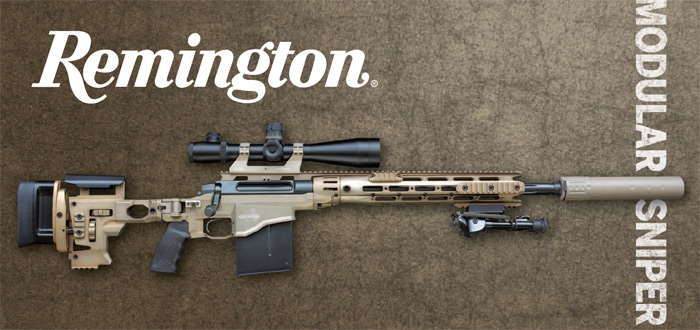เมื่อวันที่ 8 มี.ค. ได้ประกาศว่าปืน MSR ของตนชนะการประมูลในโครงการ Precision Sniper Rifle (PSR) ของหน่วยปฏิบัติการพิเศษกองทัพสหรัฐ (SOCOM) ที่เริ่มโครงการเมื่อวันที่ 15 มกราคม 2009 โดยมีมูลค่า $79.7 ล้านเหรียญ สำหรับปืน 5,150 กระบอกและกระสุนจำนวน 4,696,800 นัด
โดยปืน MSR ของเรมิงตันนี้จะนำไปทดแทนปืนซุ่มยิงแบบเก่าคือปืนเรมิงตัน M40
และปืน Mk13 ซึ่งเป็นปืนที่ปรับแต่งมาจากปืนเรมิงตัน M24
ทั้งนี้ปืน MSR สามารถยิงกระสุนได้ถึง 5 แบบแล้วแต่ลำกล้องที่จะติดตั้งมา
SOCOM Sticks With Remingtonhttp://www.strategypage.com/htmw/htweap/articles/20130318.aspx
March 18, 2013: U.S. SOCOM (Special Operations Command) recently ordered 5,150 MSRs (Modular Sniper Rifles) for about $15,000 each. This came after a competition to select the new SOCOM sniper rifle. The MSR will gradually replace the M40 and Mk13 (a customized SOCOM version of the U.S. Army M24) sniper rifles. The MSR is a bolt action rifle weighing 7.7 kg (17 pounds) and is 1.2 meters (46 inches) long with the stock extended (91cm/36 inches with the stock folded). Depending on the barrel installed it can fire one of five cartridges (.338 Lapua Magnum, .338 Norma Magnum, .300 Winchester Magnum, .308 Winchester or 7.62x51 NATO standard). Max range with the more powerful magnum rounds is 1,500 meters. The MSR uses five or ten round magazines. The older 6.8 kg (15 pounds) M24 is based on the Remington 700 hunting rifle, as is the 7.5 kg M40. The MSR is an entirely new design, and is also from Remington.
In the last decade American soldiers and marines have greatly increased their use of snipers, and the success of this move spread to other countries. The more aggressive use of snipers in the last decade is one of many changes in ground combat. In that time, because of Iraq and Afghanistan, infantry tactics have changed considerably. This has largely gone unnoticed back home, unless you happen to know an old soldier or marine that remembers the old style of shooting. Put simply, the emphasis is on a lot fewer bullets fired and much more accurate shooting. Elite forces, like the Special Forces and SEALs, have always operated this way. But that's because they had the skill, and opportunity to train frequently, to make it work. The army and marines have found that their troops can fight the same way with the help of some new weapons, equipment, and tactics, plus lots of combat experience and specialized training. This includes the use of new shooting simulators, which allows troops to fire a lot of virtual bullets in a realistic setting, without all the hassle and expense of going to a firing range.
Currently, about ten percent of American infantry are trained and equipped as snipers (or “sharpshooters”). Commanders have found that filling the battlefield with two man (spotter and shooter) sniper teams not only provides more intelligence but also a lot of precision firepower. Snipers are better at finding the enemy and killing them with a minimum of noise and fuss. New rifle sights (both day and night types) have made all infantry capable of accurate, single shot fire. With the emphasis on keeping civilian casualties down, and the tendency of the enemy to use civilians as human shields, a lot of snipers, or infantrymen who can take an accurate shot at typical battle ranges (under 100 meters), are the best way to win without killing a lot of civilians.
New sniper equipment has made a big difference. During the last decade the U.S. Army has issued several new sniper rifles. The M110 SASS (Semi-Automatic Sniper System) was delivered to troops in Iraq and Afghanistan in 2008. This weapon is not a big technological breakthrough. It is based on the older AR-10 rifle. The 1.03 meter (40.5 inch) long rifle can have a 15 cm (six inch) tube attached to the barrel, which reduces the noise and flash made when the rifle fires, and largely eliminates nearby dust rising into the air, which often gives away the sniper's position. In the last few years, snipers have adopted some more powerful rounds (like the .338 Lapua Magnum and the .300 Magnum) and ever more useful accessories. Several sniper rifle models were modified to handle the longer range rounds (by replacing the barrel and receiver).
Previously, many snipers have had success using tuned up M14s (from the 1960s) as sniper rifles. While semi-automatic and rugged, the M14 wasn't designed to be a sniper rifle. The AR-10 was a better model for a semi-automatic sniper rifle, since it is inherently more reliable and accurate. As far back as World War II, it was known that there were many situations where a semi-automatic sniper rifle would come in handy. But it's taken over half a century to solve the reliability and accuracy problems.
The M110 has largely replaced the bolt-action M24 and provided commanders with much more effective snipers. That increase in numbers (of snipers) and their effectiveness, has changed the look (less random fire from U.S. troops) and feel (the U.S. troops appear more in control) of the battlefield. It's also easier to spot the enemy. He's usually the guy firing on automatic. The fellows firing one shot at a time are the Americans and they are usually the last ones standing.




No comments:
Post a Comment